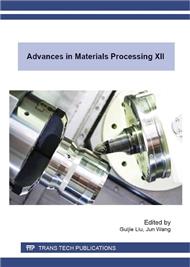p.3
p.9
p.14
p.20
p.26
p.32
p.38
p.44
p.50
An Experimental Study on Finish Dry Milling of AISI 321 Stainless Steel
Abstract:
The milling of AISI 321 stainless steel which has wide engineering applications particularly in automobile, aerospace and medicine is of great importance especially in the conditions where high surface quality is required. In this paper, L16 orthogonal array design of experiments was adopted to evaluate the machinability of AISI 321 stainless steel with coated cemented carbide tools under finish dry milling conditions, and the influence of cutting speed ( V ), feed rate ( f ) and depth of cut ( ap ) on cutting force, surface roughness and tool wear was analysed. The experimental results revealed that the cutting force decreased with an increase in the cutting speed and increased with an increase in the feed rate or the depth of cut. The tool wear was affected significantly by the cutting speed and the depth of cut, while the effect of the feed rate on the tool wear was insignificant. With the cutting speed increased up to 160 m/min, a decreasing tendency in the surface roughness was observed, but when the cutting speed was further increased, the surface roughness increased. The effect of the feed rate and the depth of cut on the surface roughness was slight.
Info:
Periodical:
Pages:
26-31
Citation:
Online since:
July 2016
Authors:
Price:
Сopyright:
© 2016 Trans Tech Publications Ltd. All Rights Reserved
Share:
Citation:


